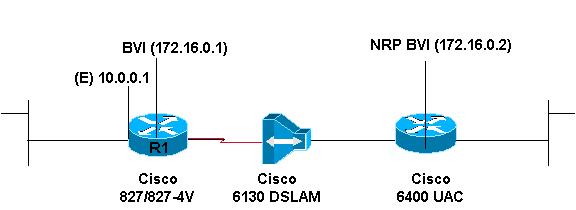Configuring a Cisco 827 Router With IRB, NAT, DHCP, and a Cisco 6400 With IRB Using RFC1483 Bridging (aal5snap)
Available Languages
Contents
Introduction
This sample configuration shows a Cisco 827 Digital Subscriber Line (DSL) Router connecting to a Cisco 6130 Digital Subscriber Line Access Multiplexer (DSLAM) and terminating on a Cisco 6400 Universal Access Concentrator (UAC).
The Cisco 827 is configured as follows:
-
With Integrated Routing and Bridging (IRB)
-
Using encapsulation
-
With Network Address Translation (NAT)
-
As a Dynamic Host Configuration Protocol (DHCP) server that will lease IP addresses to its local Ethernet clients
The Cisco 6400 is configured with IRB.
Before You Begin
Conventions
For more information on document conventions, see the Cisco Technical Tips Conventions.
Prerequisites
There are no specific prerequisites for this document.
Components Used
The information in this document is based on the software and hardware versions below.
-
Cisco 827-4V Customer Premises Equipment (CPE) IOS® Software Release 12.1(1)XB
-
Cisco 6400 UAC-Node Route Processor (NRP) IOS Software Release 12.0(7)DC
-
Cisco 6400 UAC-Node Switch Processor (NSP) IOS Software Release 12.0(4)DB
-
Cisco 6130 DSLAM-NI2 IOS Software Release 12.1(1)DA
The information presented in this document was created from devices in a specific lab environment. All of the devices used in this document started with a cleared (default) configuration. If you are working in a live network, ensure that you understand the potential impact of any command before using it.
Configure
In this section, you are presented with the information to configure the features described in this document.
Note: To find additional information on the commands used in this document, use the Command Lookup Tool (registered customers only) .
Network Diagram
This document uses the network setup shown in the diagram below.

Configurations
This document uses the configurations shown below.
| Cisco 827 |
|---|
Current configuration: ! version 12.0 service timestamps debug datetime msec service timestamps log datetime msec ! hostname R1 ! ip subnet-zero ! ip dhcp excluded-address 10.0.0.1 ! ip dhcp pool <pool name> network 10.0.0.0 255.0.0.0 default-router 10.0.0.1 ! bridge irb ! interface Ethernet0 ip address 10.0.0.1 255.0.0.0 no ip directed-broadcast ip nat inside no ip mroute-cache ! interface ATM0 no ip address no ip directed-broadcast no ip mroute-cache no atm ilmi-keepalive pvc 1/150 encapsulation aal5snap ! bundle-enable bridge-group 1 hold-queue 224 in ! interface BVI1 ip address 172.16.0.1 255.255.0.0 no ip directed-broadcast ip nat outside ! ip nat inside source list 1 interface BVI1 overload ip classless ip route 0.0.0.0 0.0.0.0 172.16.0.2 no ip http server ! access-list 1 permit 10.0.0.0 0.255.255.255 bridge 1 protocol ieee bridge 1 route ip ! voice-port 1 timing hookflash-in 0 ! voice-port 2 timing hookflash-in 0 ! voice-port 3 timing hookflash-in 0 ! voice-port 4 timing hookflash-in 0 ! end |
| Cisco Access 6400 NRP |
|---|
Current configuration: ! version 12.0 service timestamps debug datetime msec service timestamps log datetime msec no service password-encryption ! hostname NRP ! ip subnet-zero ! bridge irb ! interface ATM0/0/0 no ip address no ip directed-broadcast no ip route-cache no ip mroute-cache no atm ilmi-keepalive ! interface ATM0/0/0.300 point-to-point no ip directed-broadcast no ip route-cache pvc 1/150 encapsulation aal5snap ! bridge-group 1 ! interface Ethernet0/0/1 no ip address no ip directed-broadcast ! interface Ethernet0/0/0 no ip directed-broadcast ! interface FastEthernet0/0/0 no ip address no ip directed-broadcast full-duplex ! interface BVI1 ip address 172.16.0.2 255.255.0.0 no ip directed-broadcast ! no ip http server ! bridge 1 protocol ieee bridge 1 route ip ! end |
In order to make sure that the wireless clients can communicate among them, configure the bridge-group 1 command on the radio interface.
When the bridge-group 1 command is issued on the radio interface, these commands are automatically issued:
-
bridge-group 1 subscriber-loop-control
-
bridge-group 1 spanning-disabled
-
bridge-group 1 block-unknown-source
Do not disable these commands. These commands are required for the wireless communication to occur. If these commands are disabled, wireless clients may not be able to communicate with each other.
Also, if the bridge-group command is not configured for the VLAN, the wireless clients are not able to get the IP address from the Dynamic Host Configuration Protocol (DHCP) server on one of the VLANs.
Verify
There is currently no verification procedure available for this configuration.
Troubleshoot
There is currently no specific troubleshooting information available for this configuration.
Related Information
Revision History
| Revision | Publish Date | Comments |
|---|---|---|
1.0 |
26-Feb-2008 |
Initial Release |
 Feedback
Feedback